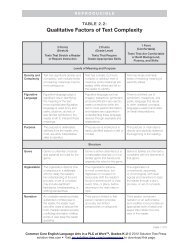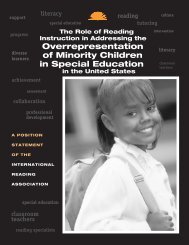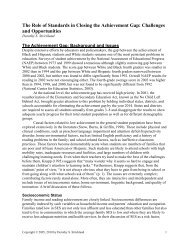Global Education Digest 2012 - International Reading Association
Global Education Digest 2012 - International Reading Association
Global Education Digest 2012 - International Reading Association
You also want an ePaper? Increase the reach of your titles
YUMPU automatically turns print PDFs into web optimized ePapers that Google loves.
OPPORTUNITIES LOST: THE IMPACT OF GRADE REPETITION AND EARLY SCHOOL LEAVING<br />
List of figures<br />
Figure 1. How many primary school-age children are out of school? 10<br />
Figure 2. At what age are children meant to begin compulsory education? 12<br />
Figure 3. How many years are children required to stay in compulsory education? 13<br />
Figure 4. To what extent are children enrolled in compulsory lower secondary education? 14<br />
Figure 5. How prevalent are over-age children in primary education? 15<br />
Figure 6. How many years can a child entering school expect to stay in school? 20<br />
Figure 7. How do trends in grade repetition and enrolment in primary education compare<br />
across regions? 21<br />
Figure 8. How do trends in grade repetition and enrolment in lower secondary education<br />
compare across regions? 22<br />
Figure 9. High but declining repetition rates in sub-Saharan Africa 23<br />
Figure 10. How has grade repetition changed in South and West Asia? 25<br />
Figure 11. How has grade repetition changed in Latin America and the Caribbean? 26<br />
Figure 12. Which grades do children repeat most often? 28<br />
Figure 13. Pupils from poor and rural households are much more likely to repeat 29<br />
Figure 14. Disparities in repetition rates are highest at the primary education level 31<br />
Figure 15. How has early school leaving changed in sub-Saharan Africa? 36<br />
Figure 16. How has early school leaving changed in South and West Asia? 37<br />
Figure 17. How has early school leaving changed in Latin America and the Caribbean? 38<br />
Figure 18. At which grade do children leave school? 39<br />
Figure 19. How old are children who leave primary school early? 41<br />
Figure 20. What share of youth completed primary and secondary education and what share<br />
left school early? 42<br />
Figure 21. How do household poverty and gender relate to the number of years of education students<br />
complete before leaving school? 43<br />
Figure 22. How do pupils perform in reading? 48<br />
Figure 23. Are rates of grade repetition and early school leaving related? 53<br />
Figure 24. How many years are spent repeating grades in primary and lower secondary education? 56<br />
Figure 25. How large are primary school classes in sub-Saharan Africa? 59<br />
List of tables<br />
Table 1. How many children leave primary school before reaching the last grade? 34<br />
Table 2. Are 2 nd to 4 th grade pupils learning to read? 46<br />
Table 3. How many countries take part in cross-national studies of learning achievement? 47<br />
List of boxes<br />
Box 1. Two key indicators to better examine grade repetition 18<br />
Box 2. What is the survival rate and how is it used to generate the dropout rate at the end of<br />
primary education? 33<br />
Box 3. Early school leaving in the European Union 35<br />
Box 4. What universal reading skills should all children acquire by the end of primary education? 50<br />
Box 5. New OECD estimates for the costs of grade repetition 55<br />
7

















